Hi folks! Well here we are, we’ve covered a lot of the different mana rocks in Magic over the past few weeks, from the efficient 2-cost mana rocks to the expensive 5+ category of mana mountains, but the keen eye may have noticed we saved the best for last. The 3-mana category is the most congested category with around 150 options to choose from. During the earlier days of Commander, this was the de-facto cost for good mana rocks, but as the game has evolved this category has become much more contentious as ramping at 2 mana has become more common and ramping at 4+ mana has become more potent. While we will be rating cards based on how they fare against others within their category, it’s worth noting that cards in this range will really need to carry some value in their mana fixing and/or utility to make a good case for a deck slot.
In case you’re new or just need a quick refresher: Ramping is the term for spending your mana on sources of additional mana to use on later turns. Think of it like an investment; spend more mana now to have access to more later. Due to the nature of Commander being a multiplayer format where players have high starting life totals, raw aggression isn’t as potent as it is in a 1v1 format, so the early turn are best used setting up your board and hand to be in a more advantageous state for the rest of the game. While Ramping is not the only way to aid in setting up your game plan for success, it’s widely considered to be universally helpful and always a safe addition to most decks – if not a necessity for some.
This Ramp can come in many forms, such as: adding more lands to the battlefield, creatures that tap for mana, or what we’re going to talk about today – mana rocks. A “mana rock” is a colloquial term for an artifact that’s primary purpose is tapping for mana, similar to a land.
To get started, we’re going to check out the “cycles” within the 3-mana rock category, which encompasses a set of cards that all have a similar mechanic, but span a variety of color identities. They usually come in groups of 5-10 depending on how many color combinations the cycle covers. A reminder that a lot of these cards are much more similar than at the other costs.
We’re going to use a good old letter grade tier list to generally rank all of our options on how easily they can be included in decks, but as a reminder: there will always be other cases of specific strategies, playstyles, and commanders that can make better use of these than a general point of view can show, so don’t be afraid to play these if you find a solid synergy.
Our ratings are as follows:
S: The only reason you wouldn’t include this is personal choice, other synergy, or budget.
A: Always a solid choice, or is overwhelmingly good in a specific archetype.
B: Generally a good pick, can work well in most decks or very well in others with synergy.
C: Good in niche situations or specific decks, but might be outclassed by other picks if you don’t have specific synergy with it.
D: Generally outclassed by other picks. Only playable in very particular niches or if you just like the card and it fits your deck’s theme.
Without further delay, let’s check out some cards!
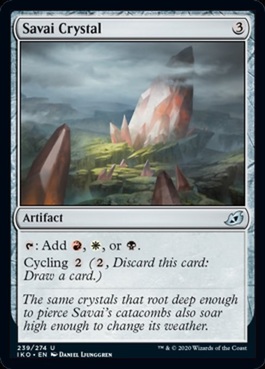
Ikoria Crystals
I’m going to preface from the get go- a lot of these cards only generate specific colors, meaning that they’re usually as effective as an “add one mana of any color” effect in a deck that only has those colors. It’s not really going to change my ratings, but it’s worth considering that these carry more value in a case where you couldn’t pick a different mana rock for more optimal fixing.
These are solid, they aren’t really special but 3-color rocks can be pretty handy since they aren’t super common, plus entering untapped is nice for a bit of a “refund” on what you paid to cast it.
In terms of the cycling effect, it gives you a good case for the issue of “if I play all this ramp, what if I get stuck with it when I don’t need it?” Compared to cards that sacrifice themselves for card draw, this has a slightly more flexible timing and doesn’t require it to be on the board, so you don’t need to front the casting cost if you want to just use it for a quick card draw.
Rating: B, Personally I do prefer cycling to the other effects that let you recycle mana rocks.
Of course that does have a drawback compared to…
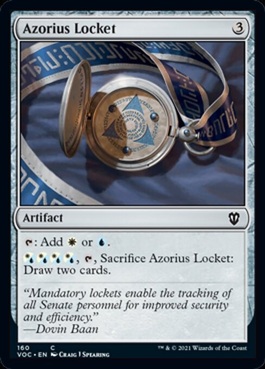
Ravnica Lockets
The lockets are functionally very similar to the Crystals (and some other cards we’ll see on this list) but they let you spend 4 hybrid mana to sacrifice it and draw two cards. This has a neat upside compared to the cycling effect of the Crystals since it lets you actually play the card and recycle it for cards later if you don’t need it. 4 mana to draw two isn’t the worst rate when it’s tacked on to a card that already is giving good value, but the downside is that 4 mana is quite a bit for some decks to hold up to react to a board wipe to get cards off this, and the decks that tend to do that often have more proactive things to do at instant speed than this, so it’s a bit of a Catch-22 for me.
That being said, they aren’t bad by any means, but to stick true to my rating system here I do have to dock them points since I value fast flexibility over the value of an extra card with these, since their main use case should be to often not be sacrificed anyway.
Rating: C, but honestly you could make a good case for it to be on par with the Crystals and I probably wouldn’t fight it.
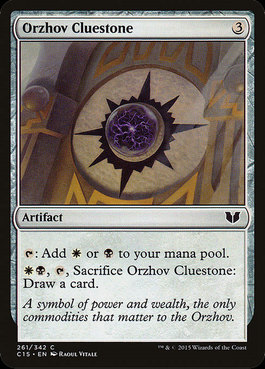
Ravnica Cluestones
These are exactly the same as above, but they only cost 2 mana to draw a single card. Again, these are very similar and pretty much come down to personal preference, but I personally do usually prefer these if I’m running one of the two since it’s easier to keep the mana open to sacrifice this reactively, and I’d rather get one card than none.
Rating: B
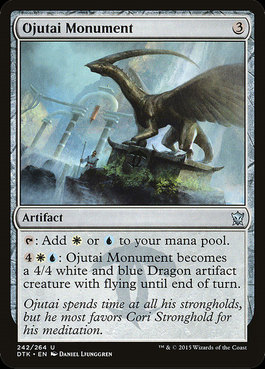
Tarkir Monuments
Man-rocks, hell yeah. These carry a lot more weight in 1v1 formats where you can use them to finish off someone with a hard-to-remove multipurpose threat, but in Commander I think I’ve seen these get activated like…maybe once? Six mana is a big ask in a format where people really want to start doing their stuff on turns 5-6, so often these feel like an emergency plan.
When your contingency plan costs more than a board wipe, you’re probably best looking for a different card to solve your problems.
Rating: D, I don’t see a lot of scenarios you play these except for off-color Dragon decks.
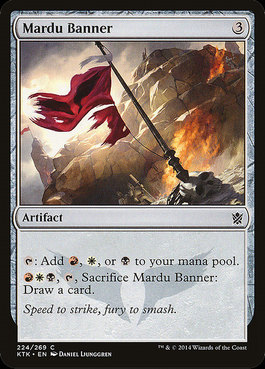
Tarkir Banners
Full disclosure, I think these suck shit. It’s 3 fixed mana to draw one card, and it generates 3 fixed mana. Compare this to Commander’s Sphere and cry.
Rating: D, for Dromoka can keep it.
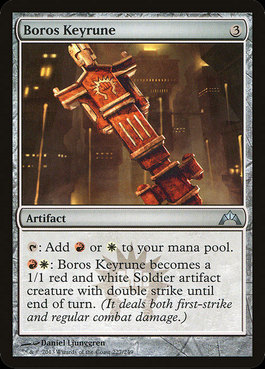
Ravnica Keyrunes
I quite like these compared to the Monuments because they’re all 2 mana to actually make a creature. That gives them quite a bit of flexibility, although I do think the value changes based on which one you’re using since the creatures have different abilities. Boros with double strike means it can carry equipment for you in a pinch, Dimir Keyrune is unblockable and Izzet Keyrune can rummage for you. They aren’t all stars and I definitely don’t think they rate better than just drawing cards, but in the right deck they’re cheap enough to have a bit of play here and there.
Rating: C
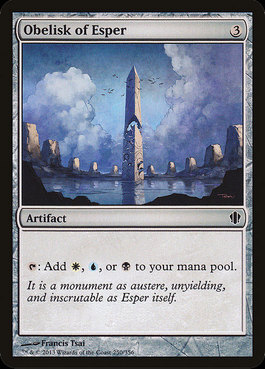
Alara Obelisks
These have been power crept by the other cards on this list and you should only use these for theme…in most cases.
I think the one neat use case for these is budget 5 color mana bases because these cards are basically free, which is nice. They honestly still are pretty crud there, but if you’re on a strict budget there’s something to be said about a card worth unironically pennies.
Rating: D
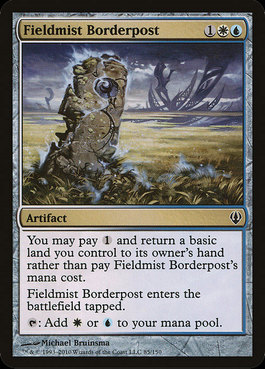
Borderposts
If you’re just jamming these in a regular deck with no synergy, I think they’re not particularly great because going back on lands just usually isn’t worth it when artifacts are more fragile than lands, but there is a neat tech with this that I specifically think applies to the Fieldmist Borderpost/any of these in a white deck.
Catchup ramp like Knight of the White Orchid and Keeper of the Accord, among many others, benefit strongly from you being at a lower land count from other players. Bounce lands like Azorius Chancery can help with this, but if you play the Borderposts you can basically “replace a basic untapped land” on the board with this to keep your land count lower so you can benefit more off catchup ramp. It requires some building around but its a surprisingly reliable way for white decks to push a mana advantage.
Rating: D, since this still only applies to combinations including a specific color and does need some building around, but seriously consider giving it a try.
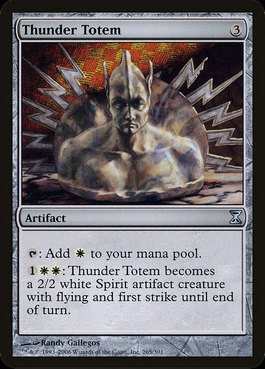
Timespiral Totems
These are mono-color rocks at 3 mana, which is already pretty meh. They’re all man-rocks like we’ve seen above, but each is pretty distinctly different. Thunder Totem probably has the best case of having good keywords and being inexpensive enough to convert that it could carry equipment well or reliably get in for combat damage triggers on players, but that’s about all these are good for.
Bonus points to Chronatog Totem for being batshit insane.
Rating: D
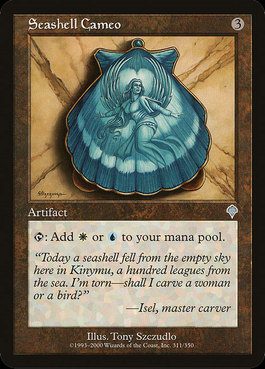
Invasion Cameos
See above with Obelisks only less so because these aren’t actually as cheap and their alternatives are better and cheaper.
Rating: Literally bottom of D unless you’re playing a sort of Old School commander, in which case you rule and don’t need me to tell you wrong.

Masques Ramos Cycle
This is my “Hear Me Out” card set of this article. I think these aren’t that bad, contrary to everything I’ve claimed up until now, particularly in mono-color decks. You might have noticed the majority of these cards have multiple colors, locking them out of single-color deck selections. While you could definitely make a reliable mana base out of just 2-cost mana rocks in a mono-color deck, this provides something unique in that it gives you extra mana in a pinch. Have a creature you really need to cast, but you want to keep up mana for an emergency counterspell in case someone casts a game ending spell? Eye of Ramos has you covered. Last second Ward got you down? Tooth of Ramos has your back.
I don’t think these are all-stars or anything but I genuinely think they aren’t half bad and I’m shocked I’ve pretty much never seen them at a table.
Rating: C in mono-color, D beyond that.
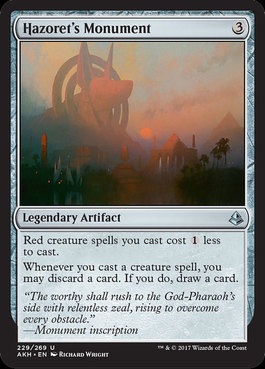
Amonkhet Monuments
I forgot to include the Medallions in my 2-cost rock article so I’m atoning for my sins here.
These aren’t technically mana rocks as they don’t generate mana, but instead provide a cost-reduction to your creatures. It goes without saying that these should really only be considered in decks that have enough creatures to warrant bringing support for them.
These have varied effects but almost all of them are absolutely great. Hazoret’s will just generate a stupid amount of rummaging in decks like Goblins and Devils. Bontu’s Monument is great with aristocrats decks and Oketra’s Monument is a solid inclusion in token decks. The other two have more niche uses (with Rhona’s Monument being redundant at times with other green ramp/support spells and Kefnet’s Monument just being more tailored to tap-down control decks), they all have a clear role and do it quite well. I think these are generally worth considering in low-color creature heavy strategies.
Rating: B as a whole, although it fluctuates for each card in the cycle since they’re quite different in function.
That’s it for today! We’ll start to dive into the non-cycle cards in this category in the next article.
Have any questions or feedback? Drop us a note in the comments below or email us at contact@goonhammer.com. Want articles like this linked in your inbox every Monday morning? Sign up for our newsletter. And don’t forget that you can support us on Patreon for backer rewards like early video content, Administratum access, an ad-free experience on our website and more.


